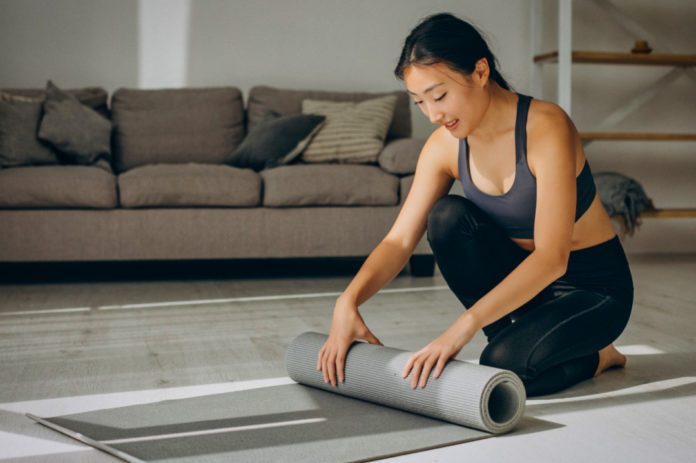Starting a home practice can be a great way to maintain and even deepen your yoga practice. It’s also a great option if you struggle to fit classes in to your schedule, or want to practice more often than is financially realistic. One great thing about a home-based practice is that it can be whatever you need it to be! It can start and end at any time, target your mood and physical needs, and use any genre or volume of music that moves you at the moment.
What is a home yoga practice?
A home yoga practice is a regular routine that incorporates some form of yoga into your life. It could include practicing yoga poses, meditating, doing yoga breathing exercises, or chanting Sanskrit mantras. Some people choose to incorporate yoga into their morning routines, others prefer to practice yoga before bedtime. A home yoga practice is highly personal—it is created and defined by your personal preferences, goals and needs. It can be done anytime that your schedule allows, and can be practiced in your home or outdoors in your yard.
Benefits of a home yoga practice vs. going to a yoga studio or gym
There are many benefits of practicing yoga in the comfort of your home. Check out the list below to learn of the reasons why you may wish to start a home yoga practice.
- You’ll save time. You don’t have to travel, park your car, or have to wait in line to check in. There also is no need to arrive early to get your favorite spot in the room!
- Less worry. In your rush to get to a class, have you ever forgotten something important like your yoga mat? Or realized when you got to class that you left your water bottle on the kitchen counter? With a home practice, these things are less likely to happen because they’re not an issue when you do them!
- You have more flexibility. You can practice anytime is best for your scheduled and needs. With a home practice, you get to decide when and where you practice. For example, maybe you’re feeling too tired after work to do a full hour class, so instead you do a few sun salutations followed by a short meditation.
- There isn’t anyone watching. If you are a beginner, you don’t have to worry about being self-conscious about how your body looks in the poses. No one will judge you if you fall off your mat! Having eyes on you during your practice can be distracting and uncomfortable. In contrast, a private home practice gives you complete control over your environment. There are no distractions, so you can fully immerse yourself in your own experience.
- You will not be tempted to judge yourself to other more advanced yoga practitioners in a class. When you go to a class with lots of students, there is always someone who has been practicing longer than you. This person may look better than you, but this doesn’t mean anything about what kind of practitioner you are.
- You have endless freedom to explore your practice. The only limit is your imagination. What would you love to try next? Maybe you’d like to add a guided visualization to your practice. How about trying a different style of asana?
- You can take breaks in child pose whenever you need to without feeling guilty about it. During a long session, sometimes we just need to rest our bodies. We might feel overwhelmed, stressed out, or physically exhausted from all the effort we’ve put forth. Taking a break allows us to reset ourselves mentally and emotionally.
- You’ll save money, especially if you do not need to rely on paid online classes. Most yoga classes cost between $14-$25 per session and online video membership fees range from $13-$22 per month.
Downsides of a home yoga practice
There may be a few downsides to practicing yoga at home. You should be aware of these limitations to plan and make adjustments accordingly.
- You will not have a yoga teacher to correct your mistakes and give you options to modify and adapt the practice to your body.
- You might need to do a lot of work to create and maintain a space for your personal practice.
- You may need to invest in some yoga props like a yoga block, bolster, blanket and yoga strap.
- You will probably stick to the basic yoga poses that you already know and not feel comfortable attempting more challenging poses without the guidance of a yoga instructor.
- You may miss the support and social aspects of public yoga classes.
- If you like hot yoga, it may be impractical to heat your yoga space enough to make you sweat.
How to start a home yoga practice
If you want to add an asana practice into your daily routine, there are a few things you need to consider before you begin. While you do not need to do everything on our list to be successful, the more you check off, the more successful your practice of yoga will become.
- Find your spot.
Beginning is as simple as identifying a place to practice. This can be a special spot dedicated to your practice, or any place where you can lay down your yoga mat and have enough room to move safely. The ideal space will be different for each person and is often influenced by your dwelling and other lifestyle factors. Wherever you practice, make the space feel sacred, inviting, and peaceful in a way that means something to you. Donna Nebenzahl suggests, “the key is to create an atmosphere that is so calming that even the family dog, with a deep sigh, is able to relax.” This calming influence can help bring your attention to your practice by allowing your focus to shift away from normal household distractions. You may choose to light candles or incense, use pictures or statues of esteemed teachers or deities, or play certain music. It can be soothing to approach the ritual of preparation with a sense of reverence; your practice has already begun! - Gather your equipment.
If you practice at home, you will probably need a mat, blocks, and other props. And if you practice outdoors, you may need a blanket, a mat, and some water. Make sure you have all of the at home yoga essentials that you need before you begin. - Choose a style of yoga that works for you.
There are many styles of yoga, each with its own set of benefits. Some styles emphasize stretching and flexibility, others focus on strength building, and still others are all about relaxation. In your personal home practice you can even combine elements from multiple styles! - Choose your focus.
Some days you may come to your mat knowing exactly what you want to work on, and move right into your practice. Other days, you may feel less inspired. There are lots of resources out there for these days. You can visit our practice section to find yoga pose sequences for all levels of ability and special sequences to match your mood. You may also find it useful to have a couple yoga books to reference and inspire you. - Start simple.
Get started with a short, basic and beginner type of practice and build from there. At the start, it is more important to build the habit of a home practice than what it looks like. Once it becomes part of your routine, then experiment with longer and more challenging practices. - Commit to a practice schedule.
Be honest and realistic with yourself, so you are more likely to stick to it. How long will you practice? What time of day will you practice? How many days a week will you practice? If you are still taking classes, it may be useful to try to practice at the same time on your off days. - Experiment and go deeper.
Once you have established a regular practice, consider experimenting with different styles and practices. Try different styles, such as Iyengar, vinyasa flow, or power yoga. Consider incorporating some yin yoga or a few restorative poses. Consider shifting your focus to a different type of movement, such as standing poses, back bends, forward folds, twists, or inversions. Add or try different types of pranayama breathing techniques. Add or try different styles of meditation, such as mindfulness, loving kindness, or mantra meditation. Find additional tips to maintain and deepen your home practice.
Home yoga practice tips
- Do what feels good. Don’t worry about being perfect.
- Be patient. Keep trying until you succeed. The best way to get better at something is to do it over and over again.
- Take breaks when necessary. Give yourself permission to stop whenever you want.
- Have fun! Remember to smile often during your practice. This helps you enjoy the process and smiling boosts endorphins, which makes us happy.
- Practice makes permanent. A daily yoga practice is ideal, but the more often you can practice, the quicker you will learn the yoga postures and breathing exercises.
- Keep learning. Find new ways to challenge yourself by looking up information on the deeper aspects of yoga or talking to experienced yogis.
- Drink plenty of water after your practice. This keeps your body hydrated and helps flush toxins through your system. It’s especially helpful if you sweat heavily in your yoga sessions.
- Get support. Ask friends and family members to help motivate you to continue your practice.
- Release attachment at attaining progress. Enjoy the process—your yoga journey is just as valuable as reaching the goal.
- Stay present. When you find your mind wandering and distracted, bring it back to the moment. See if you can notice where your attention has wandered and gently redirect it back to the awareness of breath and the sensations arising in your body.
- Release judgement and criticism. Accept where you are now and keep a positive mindset.
- Breathe deeply. Taking deep breaths throughout your practice keeps you focused and calm while providing your entire body with the oxygen and energy it needs for the practice.
- Believe in yourself. You’re capable of anything that you put your mind to.
- Trust your intuition and follow your heart. Allow your inner guidance to lead you toward success.
Conclusion
There are ten thousand things to pull you away from your practice, and even more when your practice time is dictated by someone else’s schedule. Keep going to your favorite classes, but when you can’t make them, don’t let that stop your practice! Pull out your mat at home, decide what you need, set the tone, create your practice space, and let your own inner wisdom guide you. By consciously nurturing and supporting your home yoga routine will allow you to quickly reap the amazing health benefits of yoga.


























